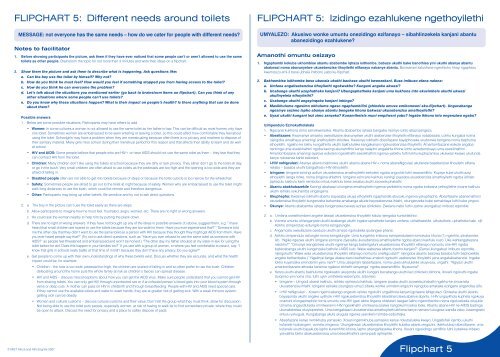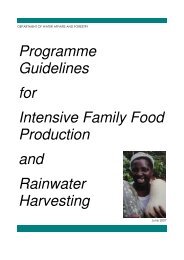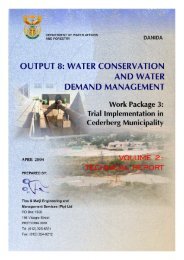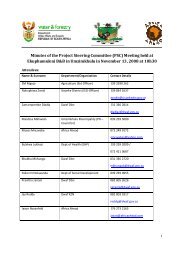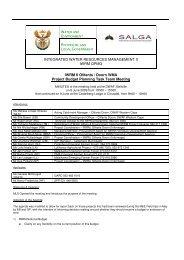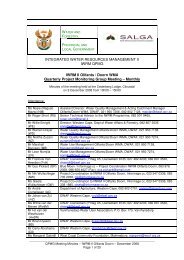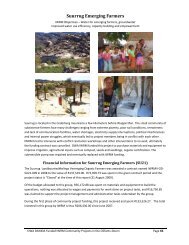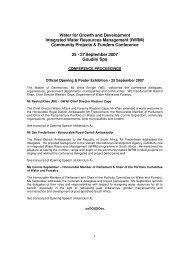You also want an ePaper? Increase the reach of your titles
YUMPU automatically turns print PDFs into web optimized ePapers that Google loves.
FLIPCHART 5: Different needs around toilets<br />
FLIPCHART 5: Izidingo ezahlukene ngethoyilethi<br />
Message: not everyone has the same needs – how do we cater for people with different needs<br />
Notes to facilitator<br />
1. Before showing participants the picture, ask them if they have ever noticed that some people can’t or aren’t allowed to use the same<br />
toilets as other people. Brainstorm the topic for not more than 3 minutes and write their ideas on a flipchart.<br />
2. Show them the picture and ask them to describe what is happening. Ask questions like:<br />
a. Can the boy use the toilet by himself Why not<br />
b. How do you think he must feel How would you feel if something stopped you from having access to the toilet<br />
c. How do you think he can overcome the problem<br />
d. Let’s talk about the situations you mentioned earlier (go back to brainstorm items on flipchart). Can you think of any<br />
other situations where some people can’t use toilets<br />
e. Do you know why these situations happen What is their impact on people’s health Is there anything that can be done<br />
about them<br />
Possible answers<br />
1. Below are some possible situations. Participants may have others to add.<br />
• Women: In some cultures a woman is not allowed to use the same toilet as her father-in-law. This can be difficult as most homes only have<br />
one toilet. Sometimes women are embarrassed to be seen entering or leaving a toilet, so this could affect how comfortable they feel about<br />
using the toilet. Schoolgirls may have a problem when they are menstruating because often there is no privacy and nowhere to dispose of<br />
their sanitary material. Many girls miss school during their menstrual period for this reason and that affects their ability to learn and do well<br />
at school.<br />
• HIV and AIDS: Some people believe that people who are HIV+ or have AIDS should not use the same toilet as them – they fear that they<br />
can contract HIV from the toilet.<br />
• Children: Many children don’t like using the toilets at school because they are dirty or lack privacy. They either don’t go to the toilet all day,<br />
or go in the bush. Very small children are often afraid to use toilets as the pedestals are too high and the opening is too wide and they are<br />
afraid of falling in.<br />
• Disabled people often are not able to get into toilets because of steps or because the toilet cubicle is too narrow for the wheelchair.<br />
• Safety: Sometimes people are afraid to go out to the toilet at night because of safety. Women who are embarrassed to use the toilet might<br />
walk long distances to use the bush, which could be remote and therefore dangerous.<br />
• Other: Participants may bring up other beliefs. Be sensitive and try not to ask direct questions.<br />
2. a. The boy in the picture can’t use the toilet easily as there are steps.<br />
b. Allow participants to imagine how he must feel: frustrated, angry, worried, etc. There are no right or wrong answers.<br />
c. He could ask the woman nearby to help him by putting the plank down.<br />
d. There are no right or wrong answers. If they have not brought up any of the ideas in possible answers (1) above, suggest them, e.g. “I have<br />
heard that small children are scared to use the toilets because they are too wide for them. Have you ever experienced that” “Someone told<br />
me the other day that they didn’t want to use the same toilet as a person with HIV because they thought they might get AIDS from them. Have<br />
you ever heard people say that” (Try not to ask direct questions, such as “Have you ever refused to use the same toilet as someone with<br />
AIDS” as people feel threatened and embarrassed and won’t be honest.) “The other day my father shouted at my sister-in-law for using the<br />
toilet before he did. Does this happen in your families too” If you are with a group of women, or where you feel comfortable to raise it, say: “I<br />
know that girls in schools really battle at ‘that time of month’ because they don’t have any privacy. Do you agree”<br />
e. Get people to come up with their own understandings of why these beliefs exist. Discuss whether they are accurate, and what the health<br />
impact could be, for example:<br />
• Children – the hole is too wide, pedestal too high, the children are scared of falling in and so often prefer to use the bush. Children<br />
defecating around the home puts the whole family at risk as children’s faeces can spread disease.<br />
• HIV and AIDS – discuss misconceptions about how you can get the AIDS virus. Make sure people understand that you cannot get HIV<br />
from sharing toilets. You can only get HIV through unprotected sex or if an infected person’s blood gets into your blood system through<br />
veins or deep cuts. A mother can pass on HIV in childbirth and through breastfeeding. People with HIV and AIDS need special care.<br />
If they cannot use the available toilets and water to wash hands, they are at greater risk of getting sick. With a weak immune system,<br />
getting sick can be deadly.<br />
• Women and cultural customs – discuss cultural customs and their value. Don’t tell the group what they must think, allow for discussion.<br />
Not being able to use the toilet puts people, especially women, at risk of having to walk far to find somewhere private, where they could<br />
be open to attack. Discuss the need for privacy and a place to safely dispose of pads.<br />
Umyalezo: Akusiwo wonke umuntu onezidingo ezifanayo – sibahlinzekela kanjani abantu<br />
abanezidingo ezahlukene<br />
Amanothi omuntu osizayo<br />
1. Ngaphambi kokuba ukhombise abantu ababambe iqhaza isithombe, babuze ukuthi bake banothisa yini ukuthi abanye abantu<br />
abakwazi noma abavunyelwe ukusebenzisa ithoyilethi elifanayo nabanye abantu. Bonisanani kafushane ngesihloko hhayi ngaphezu<br />
kwemizuzu emi-3 bese ubhala imibono yabo ku-flipchart.<br />
2. Bakhombise isithombe bese ubacela ukuthi bachaze ukuthi kwenzekani. Buza imibuzo efana nalena:<br />
a. Umfana angalisebenzisa ithoyilethi ngokwakhe Kungani angeke akwazi<br />
b. Ucabanga ukuthi uzophatheka kanjani Ubungaphatheka kanjani uma kukhona into ekuvimbela ukuthi ukwazi<br />
ukufinyelela ethoyilethi<br />
c. Ucabanga ukuthi angayinqoba kanjani inkinga<br />
d. Masikhulume ngesimo okhulume ngaso ngaphambilini (phindela emuva emibonweni eku-flipchart). Ungacabanga<br />
ngesinye sezimo lapho abanye abantu bengeke khona bakwazi ukusebenzisa amathoyilethi<br />
e. Uyazi ukuthi kungani lezi zimo zenzeka Kunamthelela muni empilweni yabo Ingabe ikhona into engenziwa ngabo<br />
Izimpendulo Ezinokutholakala<br />
1. Ngezansi kukhona izimo ezinokwenzeka. Abantu ababambe iqhaza bangaba nezinye izinto abazozengeza.<br />
• Abesifazane: Kwamanye amasiko owesifazane akavunyelwe ukuthi asebenzise ithoyilethi elifanayo nobabezala. Lokhu kungaba nzima<br />
njengoba amakhaya amaningi anethoyilethi elilodwa. Kwesinye isikhathi abesifazane bayaphoxeka ukubonwa bengena noma bephuma<br />
ethoyilethi, ngakho-ke lokhu kungathinta ukuthi bakhululeke kangakanani ngokusebenzisa ithoyilethi. Amantombazane esikole angaba<br />
nenkinga uma esesikhathini ngoba kaningi akunamfihlo kanye nalapho angalahla khona izinto azisebenzisayo uma esesikhathini.<br />
Amantombazane amaningi ayalova esikoleni ngesikhathi esesikhathini ngenxa yalokhu futhi lokhu kuphazamisa ukukwazi kwawo ukufunda<br />
kanye nokwenza kahle esikoleni.<br />
• I-HIV neNgculazi: Abanye abantu bakholwa ukuthi abantu abane-HIV+ noma abaneNgculazi akufanele basebenzise ithoyilethi elifana<br />
nelabo – basaba ukuthi bangathola i-HIV ethoyilethi.<br />
• Izingane: Izingane eziningi azifuni ukusebenzisa amathoyilethi esikoleni ngoba angcolile futhi awanamfihlo. Kuyaye kube ukuthi aziyi<br />
ethoyilethi ilanga lonke, noma zingena ehlathini. Izingane ezincane kakhulu kaningi ziyesaba ukusebenzisa amathoyilethi ngoba izihlalo<br />
ziphezulu kakhulu kanti nembobo inkulu kakhulu bese zesaba ukuthi zizowela phakathi.<br />
• Abantu abakhubazekile Kaningi abakwazi ukungena emathoyilethi ngenxa yezitebhisi noma ngoba indlwana yethoyilethe incane kakhulu<br />
ukuthi isihlalo sokuhamba singangena.<br />
• Ukuphepha: Kwesinye isikhathi abantu bayasaba ukuya ethoyilethi ngaphandle ebusuku ngenxa yokuphepha. Abesifazane abanamahloni<br />
okusebenzisa ithoyilethi kungenzeka bahambe amabanga akude beyosebenzisa ihlathi, okungenzeka kube semakhaya futhi kube yingozi.<br />
• Okunye: Abantu ababambe iqhaza kungenzeka baveze ezinye izinkolelo. Zwelana nabo futhi uzame ukungabuzi imibuzo eqondile.<br />
2. a. Umfana osesithombeni angeke akwazi ukusebenzisa ithoyilethi kalula njengoba kunezitebhisi.<br />
b. Vumela umuntu ohlanganyele ukuthi acabange ukuthi ingabe uphatheke kanjani umfana: ukhathazekile, uthukuthele, uphatheke kabi, njll.<br />
Azikho izimpendulo ezilungile noma ezingalungile.<br />
c. Angamcela owesifazane oseduze ukuthi amsize ngokubeka ipulangwe phansi.<br />
d. Azikho izimpendulo ezilungile noma ezingalungile. Uma kungekho imibono ezimpendulweni ezinokuba khona (1) ngenhla, iphakamise,<br />
isb. “Ngike ngezwa ukuthi izingane ezincane ziyesaba ukusebenzisa amathoyilethe ngoba abanzi kakhulu kuzo. Uke wahlangabezana<br />
nalokho” “Omunye wangitshela ukuthi ngelinye ilanga babengafuni ukusebenzisa ithoyilethi elifanayo nomuntu one-HIV ngoba<br />
babecabanga ukuthi kungenzeka bathole i-AIDS kulo. Wake wabezwa abantu besho kanjalo” (Zama ukungabuzi imibuzo eqondile,<br />
njengokuthi “Wake wala ukusebenzisa ithoyilethi elifanayo nomuntu oneNgculazi” njengoba abantu bezizwa besaba futhi bephoxekile<br />
angeke bethembeke.)” Ngelinye ilanga ubaba wami wathethisa umakoti ngokuthi usebenzise ithoyilethi yena angakalisebenzisi. Ingabe<br />
lokho kuyenzeka emindenini yenu nani” Uma useqenjini labesifazane, noma uzwa ukhululekile ukuyiveza, ungathi: “Ngiyazi ukuthi<br />
amantombazane athwala kanzima ngaleso sikhathi senyanga’ ngoba awanamfihlo. Niyavuma<br />
e. Yenza ukuthi abantu bakhulume ngokwabo ukuqonda ukuthi kungani becabanga ukuthi lezi zinkolelo zikhona. Xoxani ngokuthi ingabe<br />
ziyiqiniso yini noma cha, futhi uyini umthelela wezempilo, isibonelo:<br />
• Izingane – Umgodi ubanzi kakhulu, isihlalo siphezulu kakhulu, izingane zisaba ukuthi zizowela phakathi ngakho-ke zincamela<br />
ukusebenzisa ihlathi. Izingane ezikaka zizungeze umuzi zibeka wonke umndeni engozini njengoba amakaka ezingane angandisa izifo.<br />
• I-HIV neNgculazi – Xoxani ngemicabango engesilo iqiniso ngokuthi ungalithola kanjani igciwane leNgculazi. Qiniseka ukuthi abantu<br />
bayaqonda ukuthi angeke uyithole i-HIV ngokusebenzisa ithoyilethi elisetshenziswa abanye abantu. I-HIV ungayithola kuphela ngokuya<br />
ocansini olungaphephile noma umuntu one-HIV igazi lakhe lingena ohlelweni lwegazi lakho ngemithambo noma ngokusikeka okujulile.<br />
Umama angayidlulisela emntwaneni i-HIV ngesikhathi umntwana ezalwa nangokumncelisa ibele. Abantu abane-HIV ne-AIIDS badinga<br />
ukunakekelwa okuyisipesheli. Uma bengakwazi ukusebenzisa amathoyilethi akhona kanye namanzi ukugeza izandla zabo, basengozini<br />
enkulu yokugula. Kungabanga ukufa ukugula ngenxa yezivikeli mzimba ezibuthaka.<br />
• Abesifazane kanye nemikhuba yamasiko. Xoxani ngemikhuba yamasiko kanye nokubaluleka kwayo. Ungalitsheli iqembu ukuthi<br />
kufanele licabangeni, vumela izingxoxo. Ukungakwazi ukusebenzisa ithoyilethi kubeka abantu engozini, ikakhulukazi abesifazane, uma<br />
kufanele ukuthi bayekude lapho kunemfihlo khona, lapho abangahlaselwa khona. Xoxani ngesidingo semfihlo futhi kubekwe indawo<br />
yokulahla lokho abakusebenzisa uma besesikhathini (ama-pad) ephephile.<br />
© MiET Africa and Africa!Ignite 2007<br />
<strong>Flipchart</strong> 5


